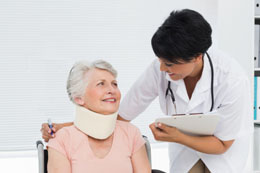Cervical bone spurs is an age-related disorder which gives rise to small bone outgrowths along the edges of the bones. In this article we have summed up the information related to the causes, symptoms, and treatments of this disorder.

Many people have the misconception that cervical bone spurs are the cause of back pain. Actually, this condition is a symptom of spinal degeneration, and mostly goes undetected. The medical name for this condition is osteophytes. It is most commonly observed among people who are above the age of 60. Spine degeneration starts in the early adulthood, but cervical bone spurs develop only in about 40 percent of the cases.
Causes
Our vertebral column consists of 32 segments which are separated from each other by spinal discs that are made of ligaments and collagen. These discs act as shock absorbers and enable the flexible movement of the spinal segments. The motion in between any two segments is restricted by the ligaments. At the back of the disc, there is a small opening (called foramina) for the exit of the nerve roots from the spinal canal. The hole is so small that only the exiting nerve can pass through it. However, with the degeneration of the disc material the ligaments become loose and the movement of the joint increases. Slowly the body compensates for the deterioration by making the ligaments that hold the bones thicker. After sometime, due to calcification of thick ligaments, formation of bone spurs begin. Thus we can say that cervical bone spurs develop as the body tries to repair the damage caused by degeneration of bone mass. The newly formed projections then start protruding into the area reserved for the nerves and thus put additional amount of pressure on the nervous system and spinal discs.
The main cause of this condition is aging. These spurs can occur if there is degeneration of discs and joints of the cervical bones because of some injury, malnutrition, excessive weight, or poor posture. Other health conditions like osteoarthritis, osteoporosis, spondylosis, etc. which can lead to breakage of cartilage are also responsible for development of this disorder.
Symptoms
When the disorder is at an early stage, it does not show any symptoms. However, due to this condition, the coordination between various parts of the body get badly affected. This may lead to nerve impingement and as a result of this, symptoms like numbness, muscle pain, weakness in muscles, neck pain, and shoulder pain are observed. Pain occurs when the cervical bone comes in contact with other bones. The pain in the neck and shoulder area gets aggravated with physical activities, and patients get substantial relief only after proper rest. At times, the cervical joint gets locked, and movement of the joint becomes difficult.
Diagnosis and Treatment
This condition can be diagnosed with the help of a MRI, CT Scan, electroconductive test, or an X-Ray. MRI and electroconductive tests are helpful in comprehending the seriousness of the nerve injury. Doctors investigate into the medical history of the patient to confirm this condition before the start of the treatment. In the conventional method of treatment, the patient is advised to take rest. They are suggested either to cut down on their physical activity, or take complete bed rest. A neck brace may also be given to some patients. For the purpose of pain relief, non-steroidal anti-inflammatory drugs (NSAIDs) or pain killers are administered to the patients. In case they are ineffective in controlling the pain, muscle relaxants are prescribed to get rid of the pain, swelling, and stiffness. If all these treatments fail to yield the desired results, then surgery is recommended for the removal of the spur.
Some people consider yoga exercises as an excellent alternative for this condition. It is believed to be helpful in strengthening of the muscles around the cervical bone and is effective in better pain management. Massage also gives temporary relief to the tension of the muscles of the affected area.


 Many people have the misconception that cervical bone spurs are the cause of back pain. Actually, this condition is a symptom of spinal degeneration, and mostly goes undetected. The medical name for this condition is osteophytes. It is most commonly observed among people who are above the age of 60. Spine degeneration starts in the early adulthood, but cervical bone spurs develop only in about 40 percent of the cases.
Many people have the misconception that cervical bone spurs are the cause of back pain. Actually, this condition is a symptom of spinal degeneration, and mostly goes undetected. The medical name for this condition is osteophytes. It is most commonly observed among people who are above the age of 60. Spine degeneration starts in the early adulthood, but cervical bone spurs develop only in about 40 percent of the cases.